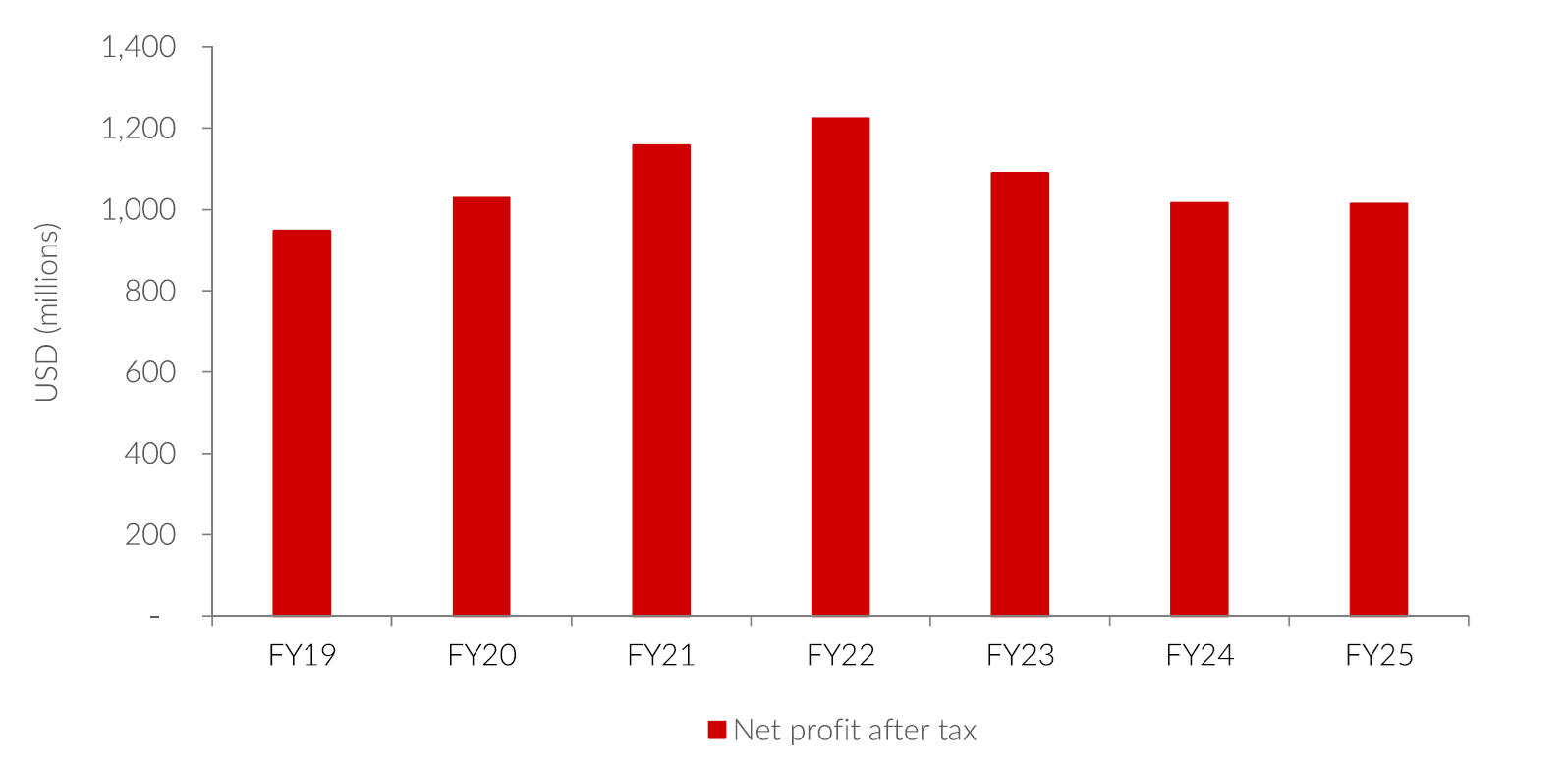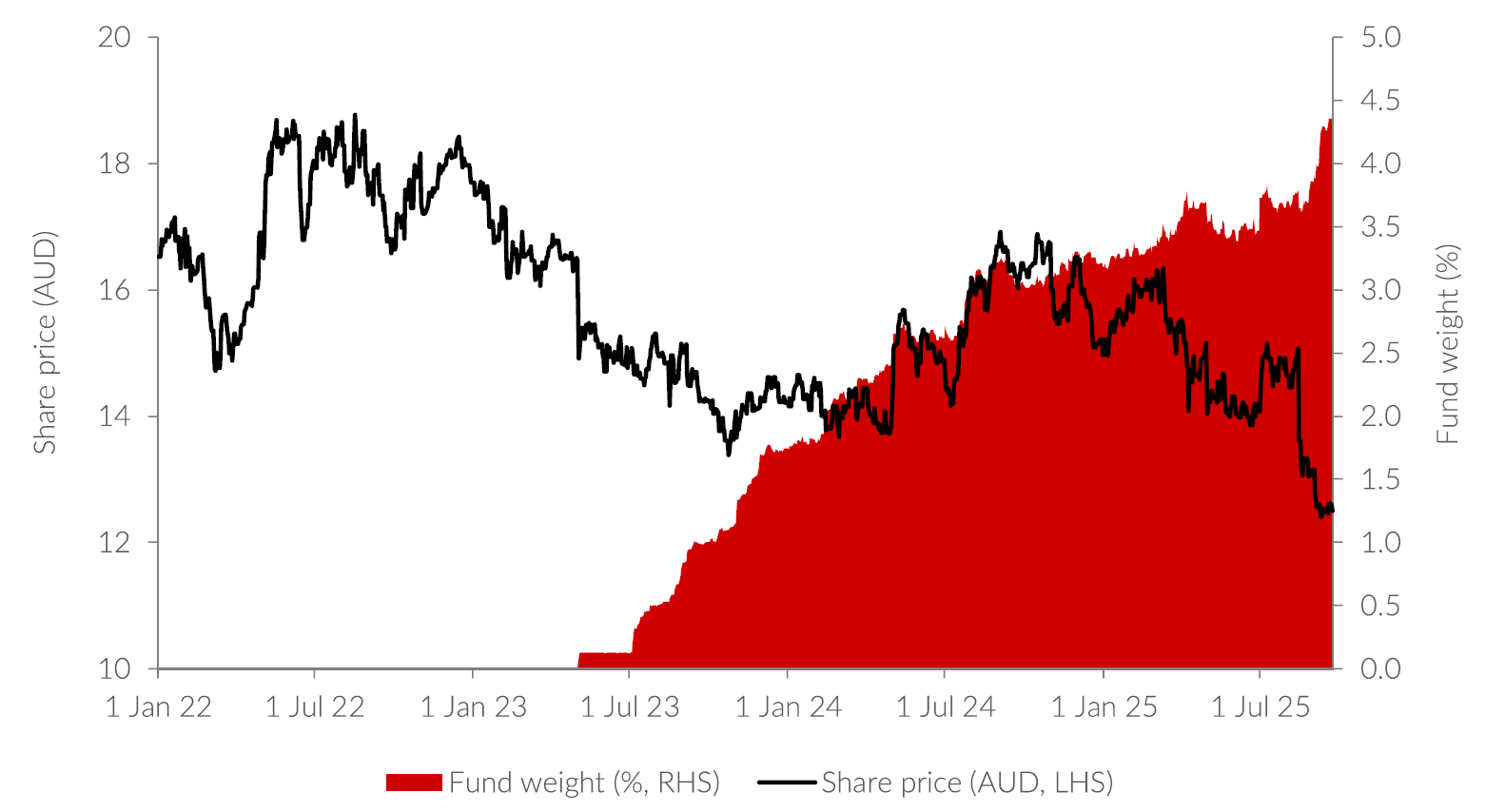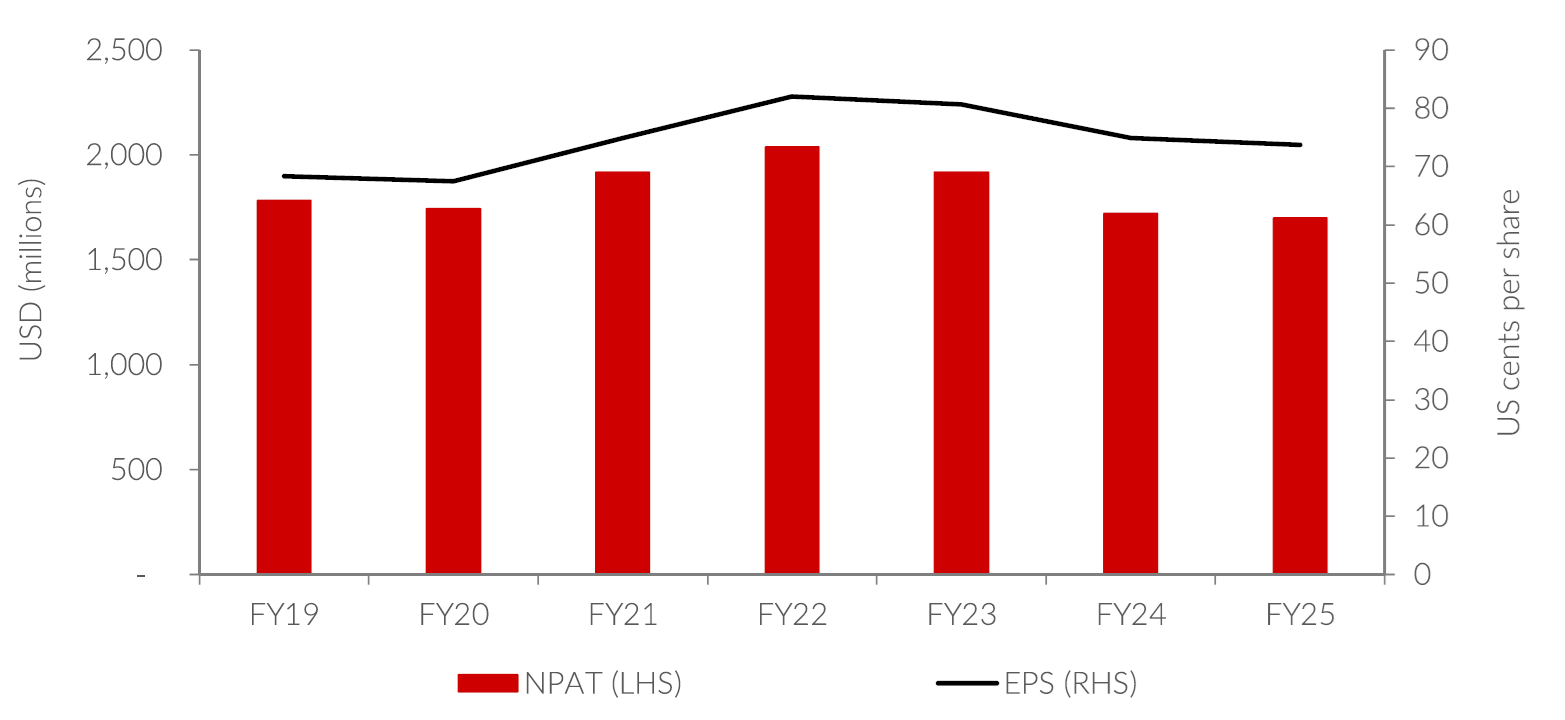Is Amcor the whole package?
While you may not have heard of Amcor (ASX: AMC), it’s likely that you have at least one product in your cupboard that’s contained in Amcor packaging. Amcor is the world’s largest manufacturer of consumer packaging and provides packaging for many household-name brands. The company has 400 manufacturing sites in more than 40 countries and sells its products in over 140 countries.
Amcor is the product of a few large mergers and acquisitions, including the acquisition of Alcan’s packaging business in 2010, Bemis in 2019 and most recently the merger with Berry in April 2025. Following the Berry merger, Amcor’s revenue exposure is approximately 50% from North America, 30% from Western Europe and 20% from emerging markets.
Amcor’s major customers include many of the world’s largest consumer goods and healthcare companies. Its priority market segments are healthcare, beauty & wellness, nutrition (including protein, dairy, snacks and pet food) and specialty products (such as films and tapes for industrial use). Examples of the products and brands Amcor works with within each of these segments are shown in Figure 1, along with the revenue contribution of each segment.
Figure 1 - Amcor’s priority market segments and their revenue contribution

Source: Amcor company reports, 23 September 2025
Why Amcor attracted our attention
In mid-2023, Amcor delivered disappointing financial results, following a period of sustained share price weakness. This is when we first invested.
During the depths of COVID-19, consumers spent more than normal on Amcor-packaged products. As shown in Graph 2, Amcor’s profitability grew strongly from financial year 2019 (FY19) to FY22. As economies opened up, economic stimulus ceased and travel restrictions relaxed. The excess consumer spending in Amcor’s key markets abated and its profits began to fall.
Aside from the excess consumer spending, another pandemicera dynamic was also at play. During the pandemic, supply chain disruptions prompted retailers to accumulate surplus inventory to avoid running out of stock. As the world returned to relative normality, most retailers were caught with too much inventory, which, with increasing interest rates, became costly to maintain. A ‘destocking’ cycle ensued, resulting, in volume declines for Amcor in the years after FY22 which adversely affected its earnings, also shown in Graph 2. Today’s earnings are lower than 2019’s in real (inflation-adjusted) terms.
Graph 2 - Amcor’s historical net profit after tax

Source: Amcor company reports, Allan Gray. Note: FY25 has been adjusted to exclude the two-months’ contribution of Berry.
We believe the sharemarket had little patience for the earnings uncertainty introduced by the destocking cycle and weakened consumer sentiment. This may be especially true for packaging companies, which historically have produced steady volume and earnings growth. Graph 3 shows how the portfolio has accumulated its holding in Amcor, predominantly as the price fell, while the market seemingly sought certainty elsewhere.
Graph 3 - Amcor’s share price and the Allan Gray Australia Equity Fund’s holding

Source: FactSet, Allan Gray, 23 September 2025. The Allan Gray Australia Equity Fund portfolio is generally representative of the Allan Gray Australia Equity strategy, which includes institutional mandates.
Does valuation still matter?
Amcor’s management has provided its expectations for earnings for the year ahead. Its expectations include synergy benefits from the merger with Berry that, if achieved, would add US$650 million to pre-tax earnings over a three-year period. Of this, US$260 million is expected to be delivered in FY26. After servicing the interest on its net debt of US$13.3 billion and paying its tax bill, management expects net profit after tax in FY26 of between US$1.85 and US$1.93 billion and earnings per share in the range of 80 US cents to 83 US cents.
But can we believe management? Graph 4 shows our estimates of the historical net profit after tax (NPAT) and earnings per share (EPS) of the Amcor and Berry businesses (had they been a combined entity) since FY19. This provides a helpful yardstick against which to compare management’s expectations.
From Graph 4, it is apparent that management’s expectations are not out of kilter with the historical earnings of the combined business. At the current share price of US$8.09, Amcor trades at a price to earnings ratio of approximately 10 times the midpoint of management’s expectations. This is half the broader market’s price to earnings ratio.
Graph 4 - Estimated financial performance of Amcor and Berry combined

Source: Amcor company reports, Berry company reports, Allan Gray. Note: FY25 has been adjusted to include our estimate of a full twelve-month contribution from Berry. Historical data has been adjusted for acquisitions and divestments.
In our experience, synergies often don’t materialise as management expects. Excluding the US$260 million of pre-tax synergy benefits earmarked for FY26, net profit after tax would be US$1.64 to US$1.71 billion, and the price to earnings ratio would be 11.2 times. We believe this is still an attractive multiple. However, a justifiable pushback is that the combined Amcor-Berry NPAT was lower in FY25 than in FY19 and therefore a discounted multiple is warranted. Our counterargument is that we believe Amcor’s FY25 earnings might be somewhat depressed, for two reasons:
- By our estimates, volumes appear to be approximately 5% lower in FY25 compared to FY19. This is unusual for a sector in which long-term volume growth before the COVID-19 pandemic was in line with GDP growth. We think this results from destocking coupled with a more cautious consumer, but we believe these are temporary circumstances and will normalise.
- Amcor’s largest customers, in aggregate, have generated organic earnings growth at a higher rate than Amcor for a prolonged period, thus capturing an increasing proportion of the profit pool in this value chain over time. One possible explanation is that the packaging sector is quite fragmented relative to its customer base. However, it’s also possible that the balance of power between packaging manufacturers and their customers might change as more consolidation occurs in the packaging sector.
The current earnings multiple provides us with a sizeable margin of safety. Earnings would need to fall 50% relative to management’s expectations for Amcor to trade at a market multiple. Such a scenario seems highly unlikely, in our opinion. So, while large parts of the market currently seem intent on avoiding stocks with even the slightest risk of missing the market’s earnings expectations, regardless of valuation, we are emphatically of the view that valuation still matters.
Maintaining a flexible stance
While we are positive on Amcor, we are careful not to be too rigid in our views. We recognise that all investments come with risk, and below we unpack the key risks that we consider with Amcor:
- While plastic packaging offers many advantages that other materials cannot emulate, be it paper, glass or aluminium, the perceptions of plastic have become increasingly unfavourable given that it is ultimately derived from the refining of fossil fuels and that it is a large contributor to waste in landfills and oceans. This could result in a reduction in demand for plastic packaging. Amcor’s volumes may be already structurally challenged.
- Amcor’s debt is uncomfortably high. Its current leverage (defined as net debt to earnings before interest, tax, depreciation and amortisation) is 3.5 times, whereas its target leverage range is 2.5 to 3.0 times.
- The merger with Berry could result in some dis-synergies. Before the merger, Amcor and Berry had a reasonable number of common customers. There is a risk that customers might want to reduce their dependence on a single supplier and divert some of their business away from Amcor.
- The strong uptake of GLP-1 drugs (such as Ozempic) as a weight-loss treatment, together with a broader shift to healthier living, might result in lower food consumption, particularly of snack foods. Amcor has a meaningful exposure to the snack food market.
While a structural weakening of packaging demand is possible, Amcor’s sheer size is one attribute in its favour. Companies that make similar products to Amcor are less than half as big, and many are a fraction of its size. Amcor therefore has a scale advantage when it comes to expenditure on research and development, which helps it to stay at the forefront of innovation. It also has scale advantages in manufacturing and in the procurement of raw materials. This would hopefully provide it with more protection than its peers in the event of a structural downturn in volumes.
On the sustainability front, while Amcor’s flexible packaging is made predominantly from plastic (80%), in recent years many of its flexible packaging products have been increasingly transitioned to paper/fibre-based materials (15%) and aluminium foils (5%) and this trend is ongoing. Its rigid packaging solutions are all made from plastic and don’t lend themselves as easily to using other materials.
Amcor’s debt is much higher than we would like, but we believe the strong cash flows that the company should generate over the next few years will enable it to reduce its debt back to its target leverage range quickly. Encouragingly, the board and management of the company have stated their commitment to doing this. Even if one were to look at Amcor on an enterprise level basis (i.e. market capitalisation plus net debt to earnings before interest and tax), it still screens cheaply relative to its own history and the S&P/ASX 300 Index. The midpoint of management’s expectation for FY26 implies earnings before interest and tax of US$2.95 billion. Amcor’s current enterprise value is US$32.0 billion. This implies an enterprise level multiple of approximately 11 times compared to the index multiple of approximately 14 times.
An attractive risk/reward profile
There will be other risks with an investment in Amcor that haven’t yet materialised. Armed with this fact, we believe our best defence against what we don’t know is to be prudent with what we do know – the price we pay. At the current earnings multiple, we believe Amcor provides us with an ample margin of safety. We focus on opportunities that remain attractive even when the future is uncertain and these are the opportunities we will continue to seek for our portfolio.
The above wire is an extract from Allan Gray Australia’s September 2025 Quarterly Commentary, which you can read in full here.
Want to learn more?
Contrarian investing is not for everyone, however, there can be rewards for the patient investor who embraces Allan Gray’s approach. Visit the Allan Gray Australia Equity Fund profiles to find out more.


1 stock mentioned
2 funds mentioned

